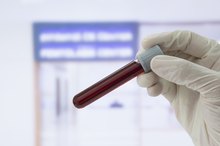Diseases That Cause Low Red Blood Count
A low red blood cell count can be a sign of anemia, a condition in which the body does not have enough normal red blood cells and the blood is unable to carry enough oxygen to the tissues that need it. Many conditions can cause a low red blood cell count; these conditions either cause red blood cells to be lost outside the body, cause excessive destruction of red blood cells or cause decreased production of red blood cells.
If you are experiencing serious medical symptoms, seek emergency treatment immediately.
Definition
A low red blood cell count is usually detected by a common blood test: the CBC, or complete blood count. A red blood cell count is generally considered low if the number of red blood cells in the sample is less than 4.2 million to 5.4 million cells per microliter of blood (cells/mcL) in women and 4.7 million to 6.1 million cells/mcL in men, although these values may vary somewhat between different laboratories.
Red Blood Cell Loss
Causes of Low HCT and HGB
Learn More
The most common cause of red blood cell loss is bleeding. The bleeding can happen rapidly -- for example, in an acute hemorrhage caused by an injury. Excess blood loss from surgery, or even frequent blood draws over time, can also lead to a low red blood cell count -- sometimes an acute one. Bleeding can also happen chronically, over a longer period. Chronic red blood cell loss in women is often caused by heavy menstruation. Chronic blood loss can also occur when a lesion in the intestinal system, such as a benign polyp or malignant tumor, results in bleeding.
- The most common cause of red blood cell loss is bleeding.
- Excess blood loss from surgery, or even frequent blood draws over time, can also lead to a low red blood cell count -- sometimes an acute one.
Increased Destruction
Red blood cells are produced in the bone marrow and circulate in the bloodstream for about 120 days. Old and damaged blood cells are normally removed by the spleen. A variety of diseases cause damage to red blood cells or cause normal red blood cells to be removed too early. Red blood cells can be fragmented when they pass through constricted or damaged blood vessels, or when passing over artificial heart valves, leading to their destruction and removal by the spleen. In blood disorders such as sickle cell anemia, the red blood cells that the body produces are abnormal and fragile and more prone to destruction. In a disorder called autoimmune hemolytic anemia, the immune system identifies normal red cells as foreign and attacks the cells with antibodies 5.
- Red blood cells are produced in the bone marrow and circulate in the bloodstream for about 120 days.
- In blood disorders such as sickle cell anemia, the red blood cells that the body produces are abnormal and fragile and more prone to destruction.
Inadequate Production
Reasons for a Low Red Blood Count of 7.7
Learn More
Certain diseases, infections and drugs can damage or interfere with the cells in the bone marrow that produce mature red blood cells, leading to a low red blood cell count. Chemotherapy drugs, given to treat cancers either in the bone marrow or elsewhere in the body, can also harm the cells that produce mature red blood cells. In a condition called myelodysplasia, the cells that produce red blood cells grow and develop abnormally and produce fewer and more abnormal red blood cells. The bone marrow can also be involved by scarring, cancer or other abnormal cells, which replace the normal marrow cells and result in decreased production of red blood cells.
- Certain diseases, infections and drugs can damage or interfere with the cells in the bone marrow that produce mature red blood cells, leading to a low red blood cell count.
- The bone marrow can also be involved by scarring, cancer or other abnormal cells, which replace the normal marrow cells and result in decreased production of red blood cells.
Related Articles
References
- MedlinePlus Medical Encyclopedia: RBC Count
- Merck Manual Professional: Etiology of Anemia -- Approach to the Patient With Anemia
- MedlinePlus Medical Encyclopedia: Sickle Cell Anemia
- National Heart, Lung and Blood Institute, National Institute of Health: What Is Aplastic Anemia
- American Family Physician: Hemolytic Anemia
- Auerbach M, Adamson JW. How we diagnose and treat iron deficiency anemia. Am J Hematol. 2016;91(1):31-38. doi:10.1002/ajh.24201
- Penn State Hersey. Milton S. Hersey Medical Center. CBC Blood Test. Updated October 24, 2018.
- Whitehead L. Managing Chemotherapy-Induced Anemia with Erythropoiesis-Stimulating Agents Plus Iron. Am J Nurs. 2017;117(5):67. doi:10.1097/01.NAJ.0000516277.58981.36
- Mohandas H, Jaganathan SK, Mani MP, Ayyar M, Rohini Thevi GV. Cancer-related fatigue treatment: An overview. J Cancer Res Ther. 2017;13(6):916-929. doi:10.4103/jcrt.JCRT_50_17
- Long B, Koyfman A. Oncologic Emergencies: The Fever With Too Few Neutrophils. J Emerg Med. 2019;57(5):689-700. doi:10.1016/j.jemermed.2019.08.009
- Bond TC, Szabo E, Gabriel S, et al. Meta-analysis and indirect treatment comparison of lipegfilgrastim with pegfilgrastim and filgrastim for the reduction of chemotherapy-induced neutropenia-related events. J Oncol Pharm Pract. 2018;24(6):412-423. doi:10.1177/1078155217714859
- National Heart, Lung, and Blood Institute. Thrombocytopenia. 2019.
- Kuter DJ. Managing thrombocytopenia associated with cancer chemotherapy. Oncology (Williston Park). 2015;29(4):282-294.
- Sunkesula VC, Knighton S, Zabarsky TF, Kundrapu S, Higgins PA, Donskey CJ. Four Moments for Patient Hand Hygiene: A Patient-Centered, Provider-Facilitated Model to Improve Patient Hand Hygiene. Infect Control Hosp Epidemiol. 2015;36(8):986-989. doi:10.1017/ice.2015.78
Writer Bio
Janna Smith has written health and fitness articles since 2000. She has co-authored papers in medical journals, including "Archives of Pathology and Laboratory Medicine." Smith is a practicing physician and Ironman triathlete. She received her medical degree from the University of Miami, and is board certified in anatomic and clinical pathology.








